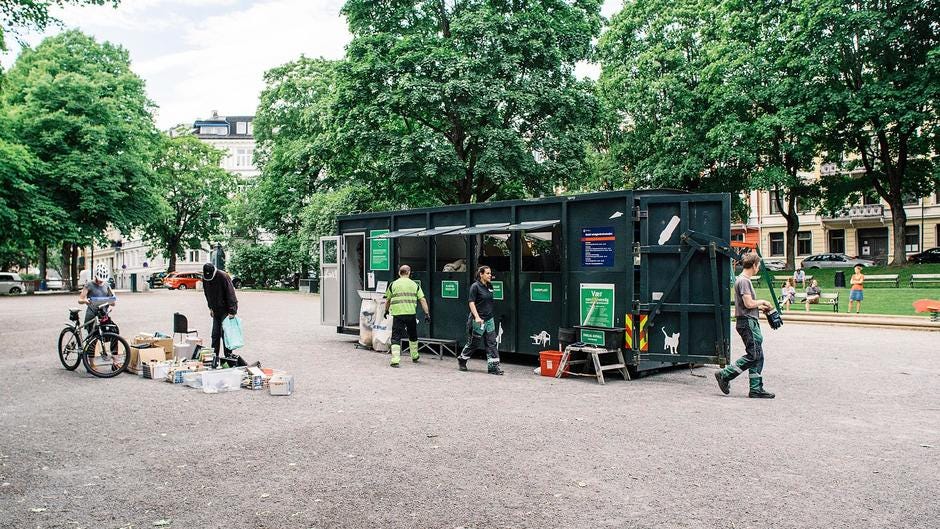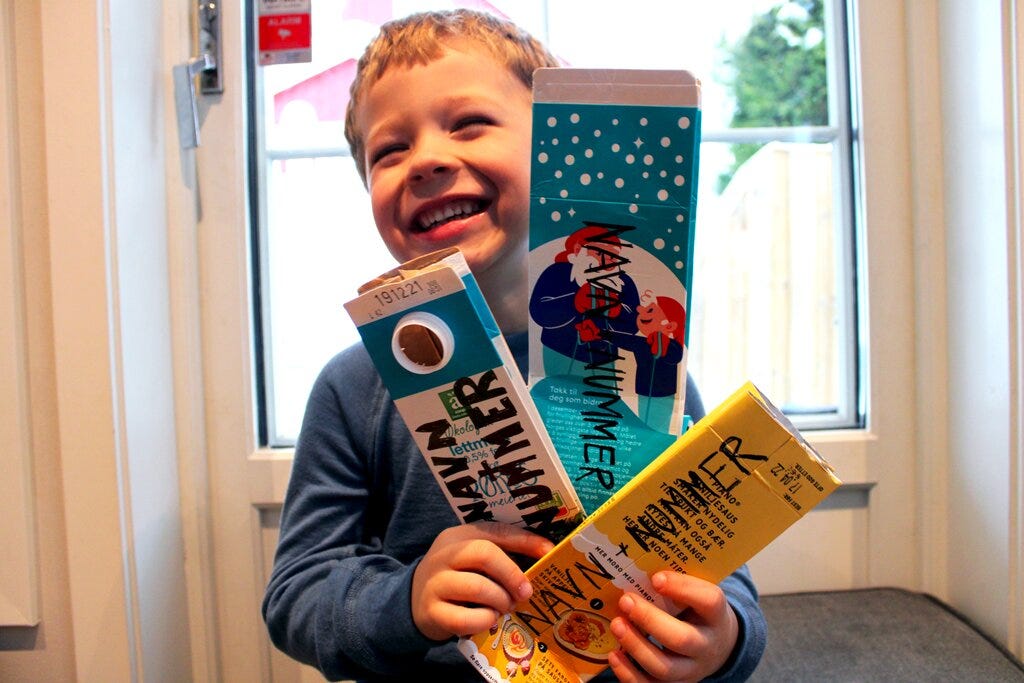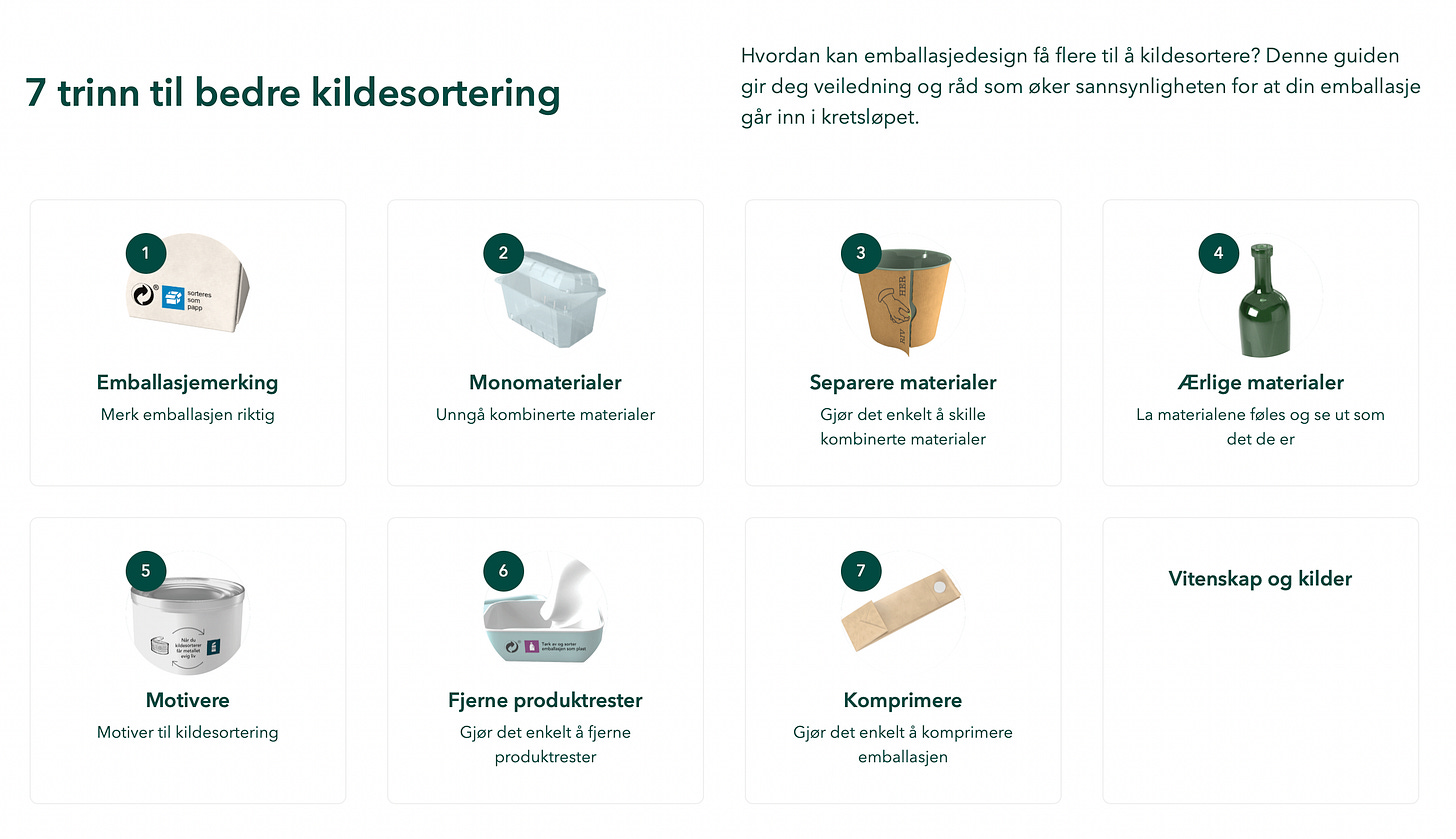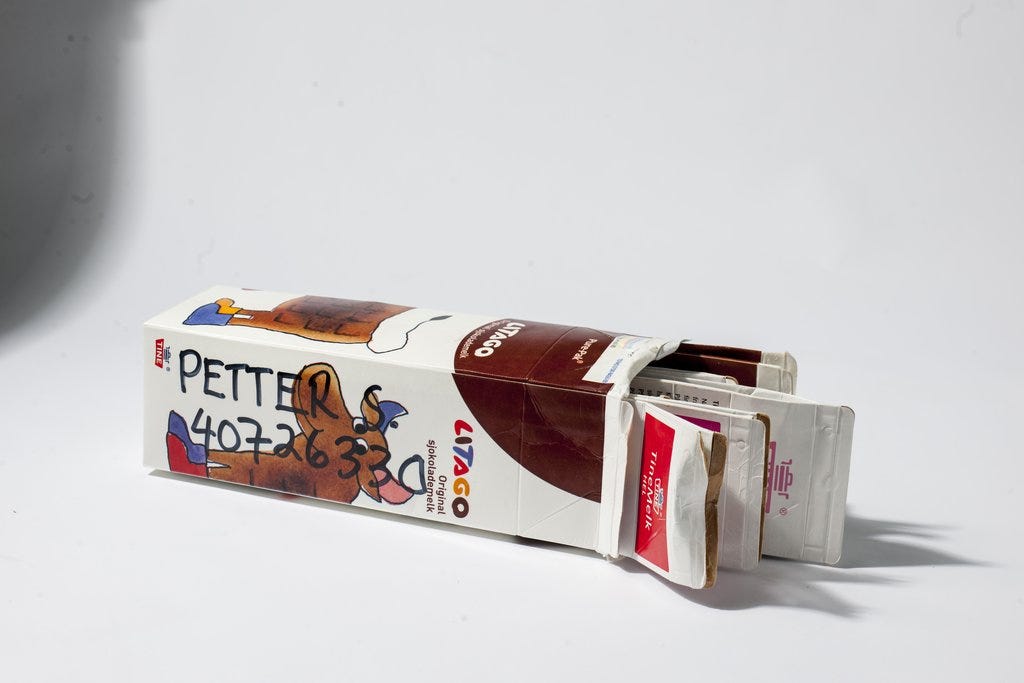Recycling is broken (in Toronto at least)
And a 🇳🇴 case study on the art of the possible within the sector
But first: my pal Vicky recently published a banger of a video where she goes super in-depth on her Obsidian-Zettelkasten setup, and how she takes notes from Capture to Publish! Go🚀check🚀it🚀out (YouTube link)!
And: It’s been really fun to meet people in the Subject to Change community, so I’m also continuing to keep parts of my calendar open for 20 minute PKM meet-and-greets with y’all!
Where to even begin.
I live in a high-rise building in Toronto. We have multi-chute systems for garbage disposal at each floor. One of the chutes is for Recyclables, aka the Blue Bin.
These are all the things we can put in the Blue Bin, according to the City of Toronto:
“This poster is a quick reference…”—wait what? a "QUICK” reference? This poster is throwing so much random information at me and is beyond cumbersome and frustrating to read, even for a compliance freak like me. More like “Where’s Waldo” and sometimes he’s in burgundy red, other times in crimson red, and sometimes he may not even be there!
But unlike the thrill of finding where Waldo really is, I’m just trying to do my part as a responsible grown-up and sort my waste properly.
Which leaves me wondering: How can we expect low-compliance folks to follow along when there are so many exceptions to pay attention to?
THE BLUE BIN ACCEPTS:
only SOME plastics; there are exceptionsonly SOME papers; btw there are exceptionsALL glass; at least this is easy peasyonly A FEW metal objects; yes there are many exceptions
It’s almost like this “quick reference” is written like Zoning by-laws:
MIXED-USE IS EVERYTHING YOU THINK FITS IN MIXED-USE, EXCEPT:
car washeslight manufacturingrepair shopsadult entertainment venuesfuneral homesevent venues over 10,000 s.f.zones that overlap with an old by-law from 1986zones with exceptions (see Appendix A Section 15.2)zones that abut mansions where rich people livezones within 500m of an ice cream shop that sells Cotton Candy flavour
But unlike developers who can hire consultants to interpret zoning by-laws, regular folks can’t be expected to do this insane legwork to decipher where waste goes. A task that should take 0.5 seconds (no-brainer) now takes 10 seconds (unintuitive) or more (tearing packaging apart to get it clean or to separate different materials) and we’re still left wondering sometimes “did I get it right?” (insert questionable packaging that has plastic and metal laminated to paper).
The poster tells us one thing: we cannot trust our intuition when it comes to sorting our waste, and that the only way to know is to consult the above waste testament (and accompanying app, if you’re really keen like me).
All this to say: The overall compliance of Toronto’s recycling program is super-low.
So low, that in an article from 2018, The Toronto Star wrote about how the city was facing a revenue shortfall because the recyclables they were selling to China were so contaminated that they got rejected.
Um. We’re selling our recyclables to China?? Yes, for a time we were sending containers full of recyclables all the way to China, for two reasons:
because we had no domestic capability to deal with waste we were generating, and
because containers were going back to China empty anyways, so it was dirt cheap to fill them with recyclables.
What actually happened in 2018 was that China decided they were fed up dealing with our dirty recyclables… or more accurately, they banned some materials and upped the compliance rates on other materials. In other words, now they only accept premium quality recyclables. Good on them, but that does leave us in a bit of a pickle… or a pile of recyclables, if I may.
So, where can we go from here?
Case study: Norway
There are many things we can do to recycle better, and most of my recommendations come from my lived experience in Norway. And fortunately for us, they have continued to improve on their recycling program since I left in 2004, so there is even more goodness that I can share with you here than I remember!
Cultural quirk alert: Norway acknowledges that most waste that is produced is just “wrapping” for another product. You therefore see the word emballasje (packaging) quite a bit in the recyclables language, instead of søppel (waste). This distinction is interesting: they don’t call it “waste” unless it is unrecyclable and goes into the garbage.
Needless to say, Norway approaches recycling a bit differently. Here are the three main principles I distilled from their approach:
Make it clear
Norway faces a similar problem as their western counterparts, which is that there is a wide variety of material types that make it difficult to generalize what’s recyclable, and what isn’t. One can’t just say “plastics” and “papers”; it’s just not enough.
To solve this, there is a slight difference in how information is presented to the recycler, and it is based on the differences I wrote about previously regarding prescriptive and proscriptive rules. In this case, Norway uses prescriptive rules. They want the instructions to be definitive, with no room for interpretation.
THIS IS RECYCLABLE:
Types of Paperregular newspaper, printer paper, junk mailcardboard“Tetrapak” style cartonsBecause of their composition of paper, plastic and sometimes metal materials compared to regular paper, they get recycled through a separate process.
Types of Plasticfood packagingpop beverage emptiesmost can be returned for a refund at any grocery store, so these are rarely found here
styrofoam
Types of Metalcans
Types of GlassClearGreen/Brown
They’ve also designed a set of easy-to-recognize symbols that every piece of packaging that is recyclable has to print somewhere.

Papers and Plastics are bagged separately and taken out with Garbage and Compost bags for local pickup. Metal and Glass, however, have to be dropped off at recycling points throughout the city. Most residents in Oslo live within 300m of a recycling point, and they often can be found at or close to grocery stores too, so you can usually deal with glass/metal recycling without taking extra trips.

Some things on this list may look too general. “Food packaging” for example encompasses a wide variety of different sizes, shapes, and types of plastic.
In Toronto, just recycling your “food packaging” would lead to “game over” in the Game of Recycling.
However, in Norway they can simply tell people to recycle their food packaging because they know that all the different types of packaging that exists in the grocery store are compliant. How do they know? For any producer that adds at least 1000kg of goods to the Norwegian market, they demand compliance with EU guidelines for packaging, and Norway’s own guidelines too in cases where they are more stringent.
And the guidelines are all about making it easier to recycle materials.
(A sidenote: I had to read Norwegian law on packaging recyclability for this section and was shocked at 1. how much cost and responsibility they download onto companies to comply with their progressive packaging law, and 2. how straight forward it was to read and understand. Why do English/Toronto laws have to be so mangled? Gah.)
Make it easy
Packaging Design
This is a really abbreviated guideline on how to design packaging for better recyclability:
According to Grønn Punkt, there are seven steps to designing packaging that improves people’s ability to recycle things:
Package markings: Mark the packaging correctly with the type of material it is
Single materials: Avoid combining different materials
Separating materials: Make it easy to separate different materials from one another
Honest materials: Let the materials feel and look like what they actually are
Motivate: Write messages to encourage recycling
Removing residue: Make it easy to remove product from the packaging
Compression: Make it easy to compress the packaging so it takes up less space
Wow, what a layup. Any packaging that complied with these guidelines would for sure be easy to recycle.
A big part of why it is so difficult to recycle in North America is because every company is allowed to basically do their own thing. The above design principles help companies design packaging that is universally easier to recycle. These guidelines take primacy over marketing departments trying to create new types of packaging that sell well, but are impossible to recycle, and this is a very good thing.
Messaging
I was blown away when I found that Grønn Punkt runs a stock photo website.

You can find photos here of anything from what a tetrapak recycling facility looks like on the inside, to pictures of cute families doing recycling together. This is but one touchpoint for proper messaging on recycling. They have many other resources to help government, businesses, organization, and individuals (like me!) spread the word - all for free, and all high quality material.
And the best message to get out there is not just to normalize and instil proper recycling habits, it is to make it look fun and easy while you’re doing it too! Speaking of fun…
Make it fun
Last but not least: it never hurts to introduce an element of fun to an otherwise everyday task.
There is this thing called the Return-Carton-Lottery (or “returkartonglotteriet” as they say) which is a program that encourages people to recycle their cartons by first compressing them flat and then putting their name and phone number on them and recycling it for a chance to win! At the recycling centre, cartons are pulled out at random and multiple prizes of 10,000NOK (about $1000USD) or 100,000NOK ($10,000USD!) are awarded every month. Now that’s a huge carrot if I ever have seen one!

I remember this program existing already back when I still lived in Oslo. My parents would rinse out all the cartons, dry them overnight, and stuff one totally full so it became a “brick” of carton. This was the instruction back in the day, to stuff cartons into bricks and then write your name and number on them. More recent recycling technology favours individual cartons pressed and folded instead, so they’ve revised the submission requirements to move away from making bricks. A huge publicity campaign was rolled out to spread the word of this new requirement far and wide.
Takeaways?
A good circular material economy won’t come quickly, or for free. But it isn’t rocket science either. Recycling requires a values-check, coordination and resources. Values-check to ensure that every one is on the same page, and understands the importance of getting materials out of landfills. Coordination because every link in the supply chain is impacted, including post-consumer and beyond. Resources because to do this kind of coordination requires a lot of time and effort. Our cities don’t come pre-built with facilities and space to do this: it is an infrastructure that needs to be built up, just like sewer systems and community centres. Info campaigns (to shift culture) are just as important as building recycling facilities domestically (to create local capacity).
In all of this, the weakest point is the end user, who currently bears the brunt of the responsibility when it comes to proper sorting. But when every point before and after the end user is so poorly designed, it’s hardly fair to blame the end user for this complete lack of coordination and investment on all levels.
(This is very similar to how we try to solve for unsafe traffic conditions: instead of designing an actual safe environment where people are ambiently nudged to do the right thing, we cover up poorly-designed roads with bandaid solutions like lots of signage and road markings, and get mad if people fail to read them. I’m not saying that road users should be excused from reading signs: what I am saying is that the safety of the road cannot solely hinge on reading signs. We need solid fallbacks. We need redundancies and ultimately more holistic safety design.)
Same for Toronto recycling: this is not a failure of graphic design and communication per se, or a failure on the end user’s part, it is a system-wide failure. To turn this around, we cannot take half measures: We must start taking waste materials seriously as a resource that can be reused, and stop at nothing to optimize every step of the way for maximum recovery and reusability.
Recycling is a topic I’m very passionate about. It frustrates me to no end that it is so hard to do the right thing in Toronto. I believe it is a matter of moral imperative that we get better at reducing our waste.
Have you experienced good examples of recycling and waste diversion where you live? I’d love to hear about your experiences and to receive more inspiration for better solutions!
Give this letter a ❤️ if you enjoyed it (and do share it with friends who may appreciate it too!)
Until next time, keep calm and carry on reducing waste.
—Fei🪢






In Portugal, I think things are simpler, and it works well, as far as I know. I'm not sure what percentage of the recycled material is used for new products, and what goes to waste or exported (if any), but I do know that a big part is used for making new products.
We have a wide network of ecobins all over the place, which are a set of three containers of different colors for the delivery of materials according to color:
- Yellow for plastic and metal packaging
- Blue for paper, cardboard, newspapers, magazines, and writing paper
- Green for glass packaging.
In some ecobins there is also a small red container for used batteries.
Additionally to this, many cities have programs for collecting recyclables door-to-door. The city offers each house some proper bins for each type/color, and on each day of the week the city services collect the recyclables for a particular color (yellow, blue, or green). In these programs, there are 2 additional bins/colors: Brown for organic materials, and Grey for generic garbage.
The instructions for the type of material for each bin are very simple, as shown above, and there are few exceptions:
- They don't distinguish types of plastic or paper, but milk and juices packages go to the yellow bin (plastics) since it is considered plastic.
- Plastic packaging don't need to be washed/cleaned, because they pass through a washing process at the recycling stations.
- Plasticized paper, paper tissues, and napkins, and paper with grease shouldn't be recycled, and go into generic garbage.
To complete the whole system, in most shopping malls and big stores, and also spread across the cities (although in much smaller numbers), there are other bins specifically for lamps, small appliances, and oils, since all of these demand special treatment.
And ultimately, there are big Ecocenters, which are facilities where people can deposit all the materials above, as well as virtually everything else (furniture, big appliances, gardening residues, etc.).
To sum up, I think the process is quite good on paper, although ultimately it relies on the cooperation of citizens, which not always happens. There are practically no incentives for recycling, except for the campaigns alerting about the importance of this process, but I guess some material or monetary incentives would bring good results.
It's very interesting the different approaches and systems (and even principles) that each country uses for recycling, thanks for writing about this.
Loved the post, as always. :)
Recycling!!! As the recycling consultant / police of my family I fully feel the frustration. It’s especially bad in Japan with 9 categories of “waste”. The recycling numbers look good here but it’s misleading because one - the top number, excessive use of plastic, is not being addressed. Two - there is a lot of contamination because of the way too detailed categorization like plastic bottle must be separate from its cap… Three - once plastic is recycled, a lot of it is burnt to generate thermal energy anyway… and what I cannot believe is there is frequently no paper recycling in offices … all in all feeling discouraged when I get upset about people not recycling properly and they say well no one does it properly so they all go to the trash anyways 😭
Oh and thank you for the shoutout 🙏🙏🙏